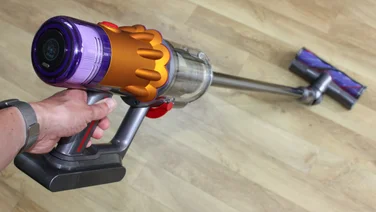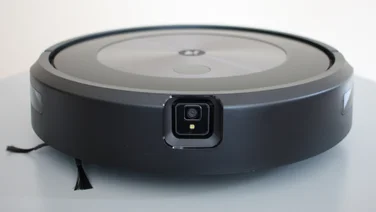To help us provide you with free impartial advice, we may earn a commission if you buy through links on our site. Learn more























- Lightweight frame
- Excellent bagless design
- Good array of accessories
- Scatters particles on hard flooring (with motorhead)
- Limited battery life and cannot be used while charging
- Small 0.54 litre bin size
Dyson’s range of vacuum cleaners can be very confusing to a layman. There are both corded and cordless vacuum models with both categories inundated with new products every year.
The V7 Animal isn’t new. Released in 2017, a year after the V8 and two years after the V6, it aims to bridge the gap between portability and performance. Is this just a filler for the British-born company or is there still a market for it in 2020?
Dyson V7 Total Clean vs Animal vs Motorhead: What’s the difference?
The V7 Total Clean comes with eight tools and accessories. In the box you’ll find:
- Motorhead
- Soft roller cleaner ‘Fluffy’ motorised head
- Quick-release mini motorhead tool
- Combination tool
- Crevice tool
- Quick-release mini soft dusting brush
- Docking station
- Charger
The V7 Animal is the next in line and doesn’t include the motorised soft-roller ‘Fluffy’ head. However, in March 2020, Dyson added a new accessory to the package, the Reach Under tool, which locks in place between the vacuum’s bin and wand. Once a button is pressed, the wand can be positioned parallel to the floor, allowing you to vacuum hard-to-access areas such as under your bed or sofa with ease.
Finally, the V7 Motorhead is the least well-equipped out of the bunch. Like the Animal, this package excludes the soft-roller cleaner head but also omits the mini soft dusting brush and the mini Motorhead tool.























READ NEXT: Best vacuum cleaner: The best vacuum cleaners to buy from £89
Dyson V6 vs V7 vs V8: What you need to know
Aside from the different variations, the V7 itself sits somewhere in-between the Dyson V6 and V8, in both its design and performance characteristics. Indeed, the V7 looks near-identical to the V8, although the latter is slightly chunkier and weighs 2.61kg while the V7 weighs 2.3kg.The V7 is less powerful at 35W than the V8 at 50, too. It has a smaller suction channel, a slightly smaller brush roll and the motorhead itself doesn’t have an extra layer of fabric to pick up dust. Despite its limitation, the V7’s motorhead still outperforms its sibling.
Its bin size is identical to that of the V8, which sits at 0.54-litre, and larger than V6, which has a capacity of 0.4 litres. None of these three cordless vacuum cleaners can compete with larger, corded alternatives, though and you’ll have to empty them fairly regularly.























As for battery life, the V7 runs for up to 30 minutes on powerful mode. The V6 lasts for 20 minutes and the V8 runs for up to 40 minutes. Crank the cordless vacuum cleaners to “Max” mode and the V7 will last you a mere 6mins, the same as the V6 and a little behind the V8, which lasts a minute longer at seven minutes. Charge time from empty to full for the V7 sits at 3hrs 30mins while the V8’s battery takes five hours to charge.























The difference between the models becomes even more confusing when comparing their suction power, where the V7 is the weakest of the lot. It has 21 Airwatts on powerful mode and 100 Airwatts in max mode. By comparison, the V8 has 22 and 115, while the V6 has 28 and 100, respectively.
READ NEXT: Dyson V8 Absolute review: Still the best cordless vacuum?
Dyson V7 Animal review: Price and competition
The most recent version of the V7 Animal, which includes the Reach Under tool, is a bit hard to come by these days, but it’s available for £300 on Amazon. The Motorhead costs £200 and the Total Clean is £320, but both seem to have been discontinued, and you will only be able to find them via third-party resellers. The newer V8 Animal retails at £350, with the V8 Absolute also costing £350 at Currys PC World.
The V6 Animal is no longer available, according to my research, meaning you’re better off sticking with the V7. The Dyson Cyclone V10 is an absolutely outstanding vacuum cleaner but is a fair bit pricier at £399. All of Dyson’s products come with a standard five-year warranty.
Elsewhere, you have a fair few options at varying price points. The Shark Cordless Stick Vacuum Cleaner will set you back £380, the Vax Blade2 Max is even dearer at £320, while the £184 Gtech AirRam MK2 and the £115 Hoover DS22HCB offer more budget alternatives.
READ NEXT: Shark DuoClean Cordless IF250UK review: Cleans the parts of your house other vacuums can’t reach
Dyson V7 Animal review: Design and features
The V7’s 2.3kg frame makes it easy to manoeuvre and carry around. In fact, compared with the Dyson Light Ball Multi Floor, which weighs 6.9kg, the V7 is a dream to use. It’s nimble, so it’s easy to use it to quickly sweep under the sofa and its cleaning head swivels and pivots smoothly, allowing you to get to clean in tight places. Having the ability to quickly switch between tools also makes the V7 a more versatile cleaner over its upright siblings. It’s simply a matter of pushing a button, detaching the existing tool and replacing with a new one.























If you’re used to a vacuum cleaner you switch on and off at the beginning and end of cleaning, the V7’s trigger system will take some getting used to. It activates the vacuum when you pull it and turns it off the instant you let go so you have to keep it depressed as you clean. This can be a little tiresome, but it does have the benefit of making your battery last a little longer because you’re the vacuum is only on when you need it to be.























That’s particularly important if you’re using the more powerful of the V7’s two modes. Although the standard mode will last you 30 minutes, the V7 will last a mere six minutes if allowed to run continuously in “Max”.
To charge the cleaner, there’s a regular DC port located at the base of the handle. Alas, you can’t clean while charging and I also found it disappointing that there’s no battery gauge; instead, a single blue LED indicates the charge status with the light turning off once the device is fully charged.























As with all vacuum cleaners, you’ll need to remove and clean the filters from time to time and these are easy to access by simply pulling the pin on top. The 0.54-litre bin is extremely easy to empty, too: by simply pulling the lever at the top, the bin door flips open and the main body of the V7 motor unit slides up, pushing out dust and debris. This not only makes it easier to empty than the V6 but also makes it a breeze to remove hairs that might have become tangled inside.
Despite its name, the V7 Animal doesn’t feature any specific ‘animal’ tools. Instead, Dyson supplies its standard full-size powered brush head for carpets and a smaller powered brush head for sofas and staircases. Also in the box are the combination, crevice and soft dusting brush, all of which will be useful but none of which are particularly good at picking up animal hair. There’s also the newly added Reach Under tool if you pick up the latest version directly from Dyson.
READ NEXT: Dyson V8 Animal review: A cheaper alternative to the Cyclone V10
Dyson V7 Animal review: Performance
I put the V7 Animal to the test on hard flooring first. Here, the lack of a soft roller or “Fluffy” head does hinder its performance with larger particles on hard flooring. The regular head works well but when its bristles encounter larger pieces of dirt, they’re often flung across the room, which isn’t ideal.























To maximise cleaning time, I mostly used the V7 Animal on its standard suction setting. The 21 “Airwatts” of power suffices for light cleaning and the 30 minutes of battery life is just about enough time for a thorough sweep of a small two-bedroom flat with hard flooring.























The same cannot be said if you’re dealing with mostly thick carpet instead of hard floors and your home is larger. Despite the Motorhead being more suited to carpets, I found myself doing several passes to achieve a thorough clean and found myself resorting to ‘max’ mode, where it jumps to a much healthier 100 Airwatts of power, although remember that the battery doesn’t last long in this mode.
I wasn’t all that impressed with the regular brush head’s ability to clean right up to the edges, either, especially compared with the Dyson Light Ball Multi Floor, which is far more impressive in this regard. It’s not all doom and gloom, though. The V7 Animal is relatively quiet in comparison to its larger wired sibling.























READ NEXT: Dyson Cyclone V10: The upright vacuum killer
Dyson V7 Animal review: Verdict
On the whole, the Dyson V7 is a well-designed cordless vacuum cleaner that’s fit for purpose. It’s not meant to replace a corded vacuum cleaner, such as the Dyson Light Ball Multi Floor or the Dyson Ball Animal 2, but it is a step up from the Dyson V6.
When we initially reviewed the V7 Animal we said it sat in an awkward place, value-wise, as it wasn’t that much cheaper than the V8. However, at £300 it’s not as costly, so if you’re not too worried about using a vacuum with a little less power, it’s a great choice for cleaning up after your pets.







